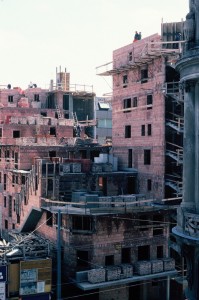The extent to which prejudices and biased opinions are rigidified against all evidence through false reporting in the press, I can describe by citing man episodes.
An opponent of Hundertwasser and the house is standing next to me, about ten meters in front of the brick shell, and says, looking at the bricks, “Aren’t you ashamed to be building an anti-ecological concrete bunker?” Even though I show him the bricks, lead him to the brick wall and let him feel the bricks, he sticks to his opinion and publishes it in the newspaper.
I have nothing against concrete.
You can build fantastic things with concrete:
For example,
1. ships (ferrocement boats); they are very popular in New Zealand, Australia and the U.S. and smell like old cathedrals inside, right in the middle of the ocean.
2. As foundations for hanging gardens and forests on the roof way up in the urban desert.
3. Invisible streets in the city, with forests outside and inside etc.
I would have agreed to a concrete shell, too, to save money. But the City of Vienna decided to build the house in brick construction, of which Vienna has only a few.
The brick walls are, quite unusually, 38 cm thick. Three types of brick were used: for the walls with outer and inner finishing hollow bricks and new solid bricks; for the portions which would be visible, the roof terraces, old solid bricks taken from torn-down houses, bearing the imperial coat-of-arms.
Concrete was used for the foundation and the basement garage, for the ceilings, for the wooded terraces with one metre of soil on the roofs, for the gateway arch, for the overhanging parts and the café terrace. If one were to cut through the house horizontally at chest height, one would only encounter brick walls in the storeys.
Hundertwasser, 1985


 English
English  Deutsch
Deutsch